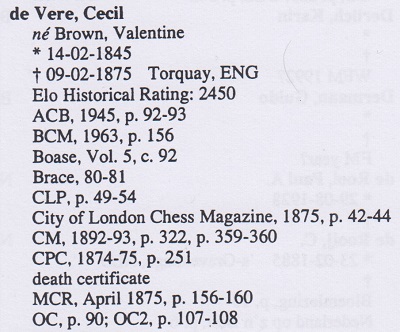
Edward Winter
From the privately circulated 1994 edition of Chess Personalia by Jeremy Gaige:

As mentioned on page 207 of A Chess Omnibus, a monograph on the nineteenth-century master subsequently appeared: “The English Morphy”? The Life and Games of Cecil De Vere First British Chess Champion by Owen Hindle and Bob Jones (Exmouth, 2001).
Moreover, after publication of his book Hindle found that De Vere’s year of birth was 14 February 1846 and that his full birth name was Valentine John Cecil De Vere Mathews; see the BCM material which is referred to in C.N. 11987 below. Thus Gaige’s ‘né Brown, Valentine’ is also incorrect.
John Townsend remarks to us:
‘The only known occasions when the name “Brown” was applied to him were, firstly, on his death registration by the General Register Office (March quarter 1875, Newton Abbot, volume 5b, page 145) and, secondly, in the burial register of Torquay cemetery, 10 February 1875. In both these instances, he was referred to as Cecil Valentine Brown.’
***
The present article brings together the small number of C.N. items written about De Vere.
***
It tends to be forgotten that in 1866 there was some criticism of Steinitz’s wish to play a match against Anderssen. For example, the following appeared on page 379 of the February 1866 issue of the Chess World:
‘… the error committed by Mr Steinitz in consenting to this match is as nothing compared to that which he is rumoured to have in contemplation, to wit, the challenging of Mr Anderssen to a contest, upon even terms, for £100 a side! We suspect, however, and hope that this absurd report will prove to be an idle hoax.’
‘This match’ was a reference to Steinitz’s encounter with De Vere, in which he gave the odds of pawn and move. De Vere won with a score of +7 –3 =2.
(2508)
From page 87 of Cabbage Heads and Chess Kings by B. Hayden (London, 1960):

Where did Potter make the remark ‘Death does not sanctify the lie’? His obituary of De Vere on pages 42-44 of the March 1875 City of London Chess Magazine ended rather differently:
‘We have endeavoured to give an unvarnished account of Mr De Vere’s career, and it is nothing to us that some may disapprove thereof, for we do not share the views of those who hold that the grave sanctifies insincerity.’
(7741)
A game played at the odds of pawn and two moves (remove Black’s f-pawn):
1 e4 ... 2 d4 c5 3 Qh5+ g6 4 Qxc5 Nc6 5 d5 e6 6 d6 b6 7 Qg5 Qxg5 8 Bxg5 Bxd6 9 Nf3 h6 10 Bd2 Nf6 11 Bd3 e5 12 Nc3 Nb4 13 a3 Nxd3+ 14 cxd3 Ba6 15 Ke2 Bc7 16 Rac1 Rc8 17 b4 Ke7 18 b5 Bb7 19 Nd1 d5 20 Bb4+ Ke6 21 Nd2 dxe4 22 dxe4 Nxe4 23 f3 Nxd2 24 Bxd2 Bd6 25 Ne3 Bxa3 26 Ra1 Bc5 27 Rxa7 Rh7 28 Ra2 Rd7 29 Rc1 e4 30 f4 h5 31 h3 Rd3 32 g4 hxg4 33 hxg4 Rh8 34 f5+ gxf5 35 gxf5+ Kf6 36 Rf1 Rh2+ 37 Rf2 Rxf2+ 38 Kxf2 Bc8 39 Ke2 Bxf5 40 Ra4 Bg6 41 Ra2 Bh5+ 42 Kf2 Be8 43 Rb2 Bd4 44 White resigns.
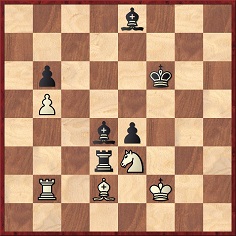
With no particulars other than the players’ names (Watts v De Vere) the game was on page 70 of the Chess Player’s Scrap Book, May 1907 with this introduction by Lasker:
‘Elegance is writ large over this game at the odds of pawn and two moves. To begin with, the odds giver does not demur to exchanging queens, efforts to avoid which being the cause of the loss of many games at odds. The beauty of the game does not depend upon any manoeuvre or move. Black simply obtains a gradual mastery over the position until at the finish we see a beautiful little miniature. White can move nothing without serious loss.’
The game is on page 110 of the monograph on Cecil De Vere, “The English Morphy?” by Owen Hindle and Bob Jones (Exmouth, 2001), White being identified as J.J. Watts and the occasion specified as ‘City of London Chess Club – 1871. Handicap Tournament’.
Another game in that book, De Vere’s short win over Minchin (‘Westminster Chess Club, 8 November 1871’ – see page 113), was given by Lasker on page 33 of the Chess Player’s Scrap Book, March 1907 without notes but with this introduction:
‘From the fact that games finished in a few moves generally contain at least one very bad move, we are often led to believe that bad play is essential in the production of a short game. Whatever dispels an illusion is something to be thankful for. We see nothing in this game until it is all over to warrant any expectation that a crisis was so near. The experience gained in playing over such games demonstrates the weakness of the seductive P-KR3 to a remarkable degree.
From that point of view this game deserves studying. The final problem-like position is interesting and curious.’
1 e4 e5 2 Nf3 Nc6 3 Bb5 Nf6 4 O-O Nxe4 5 Re1 Nd6 6 Nxe5 Be7 7 Nc3 O-O 8 d4 Bf6 9 Bd3 h6 10 Nd5 Ne8 11 Qg4 d6 12 Qe4 g6 13 Nxf7 Rxf7 14 Qxg6+ Kf8 15 Bxh6+ Bg7 16 Qh7 Ne7 17 Qh8+ Ng8 18 Bh7 Resigns.
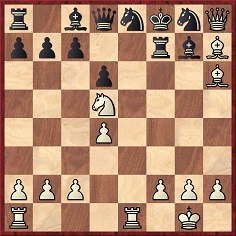
(10504)
On the theme of the double bishop sacrifice, a footnote on page 185 of Amos Burn A Chess Biography by Richard Forster (Jefferson, 2004) had a late addition:
‘However, in the BCM, December 2003, page 666, O. Hindle draws attention to an even earlier specimen by Cecil De Vere from The Field, 14 September 1867 [page 225].’
(11207)
The game (remove Black’s knight at g8) between an amateur and Cecil De Vere, London, 1867 which was mentioned in C.N. 11207: 1 e4 d5 2 exd5 e6 3 dxe6 Bxe6 4 Nf3 Bd6 5 Be2 Nc6 6 Bb5 Bd7 7 O-O O-O 8 Bxc6 Bxc6 9 d3 Re8 10 c3 Re6 11 Nd4
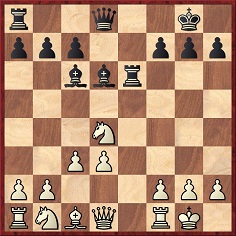
11...Bxh2+ 12 Kxh2 Qh4+ 13 Kg1 Bxg2 14 Kxg2 Rg6+ 15 Kf3 Re8 16 Rg1 Rf6+ and mates in three moves.
As noted in C.N. 11207, the game was found by Owen Hindle in The Field, 14 September 1867 and given on page 666 of the December 2003 BCM (in the Quotes and Queries column conducted by Chris Ravilious). It was discovered after publication of the monograph on De Vere, “The English Morphy?” by Owen Hindle and Bob Jones (Exmouth, 2001).
Fabrizio Zavatarelli (Milan, Italy) points out a passage on page 16 of Why Lasker Matters by Andrew Soltis (London, 2005), in the game Lasker v Bauer, Amsterdam, 1889:
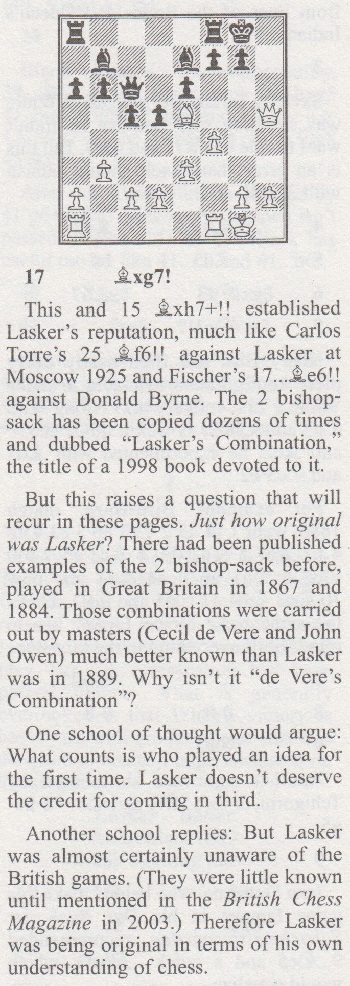
C.N. 11207 commented: ‘Specifying sources is not only an act of fairness to earlier writers but also a way of ensuring that relevant background information is known.’ Soltis did not name the researchers who found the 1867 and 1884 games (Owen Hindle and Richard Forster respectively) or, indeed, the author of Lasker’s Combination (Victor Charushin). The assertion by Soltis that the Burn v Owen game was ‘little known until mentioned in the British Chess Magazine in 2003’ is incorrect (see C.N. 11207).
(11211)
For further details see The Double Bishop Sacrifice.
From John Townsend (Wokingham, England):
‘Cecil De Vere was illegitimate, and the identity of his father has been a mystery. Now, some new information has been found in the death certificate of his mother, Katherine De Vere (General Register Office, Sept. qtr. 1864, Pancras, volume 1b, page 41). It shows that she died on 7 July 1864 at 10 Lower Calthorpe Street (Grays Inn Road, London), the informant being Eliza Hooker, “present at death”, of the same address. The cause of death was “Cancer Uteri 2 years”; her age was given as 42, and she was described as the widow of Alexander De Vere, naval surgeon.
The name Alexander De Vere is new. This occupation of her alleged late husband is consistent with information entered on Cecil De Vere’s 1846 birth certificate, where the father’s name was left blank (indicating illegitimacy), but his occupation was nevertheless entered as “surgeon”. The birth certificate was discussed by Owen Hindle in the Quotes & Queries column of the BCM, conducted by Chris Ravilious, in December 2003, February 2004 and November 2005.
Katherine De Vere had already been living at the address where she died at the time of the 1861 census, when she was described as a widow, aged 36, born in Wales (National Archives, RG 9 107, folio 91, page 9). At that time, she had as lodgers Francis Burden, a civil engineer, and Albert Lane, a landscape painter, both chessplayers, who taught the young De Vere to play.
It has not so far been possible to identify the individual referred to as Alexander De Vere, and he will need to be the subject of ongoing research. Likewise, details of his supposed marriage to De Vere’s mother have not been readily found.
De Vere’s mother was buried in Brompton Cemetery on 11 July 1864 in a private grave paid for by “Valentine De Vere”, “gentleman”, of the same address. There was neither probate nor letters of administration.’
Illustrations of the chessplayer are rare. Below is a detail of the Redcar, 1866 group photograph in C.N. 5614:
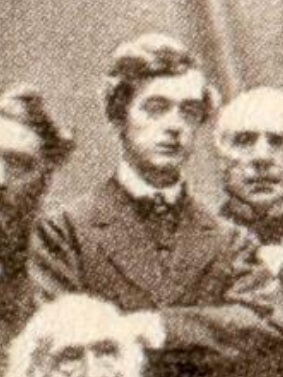
(11978)
See also The Chess Masters of To-day by Leopold Hoffer.
To the Archives
for other feature articles.
Copyright Edward Winter. All rights reserved.